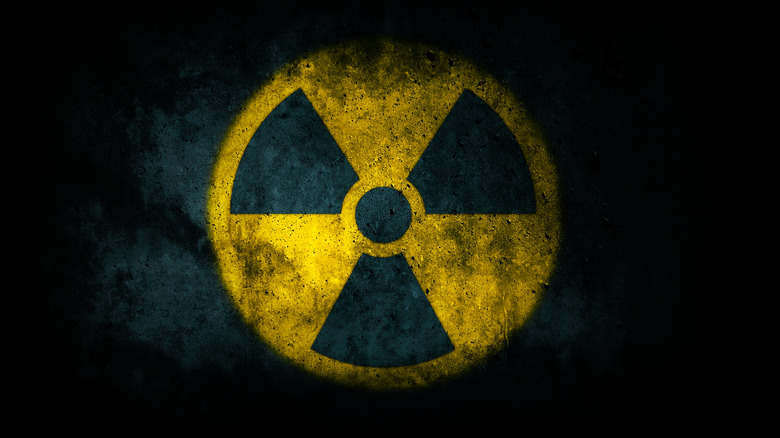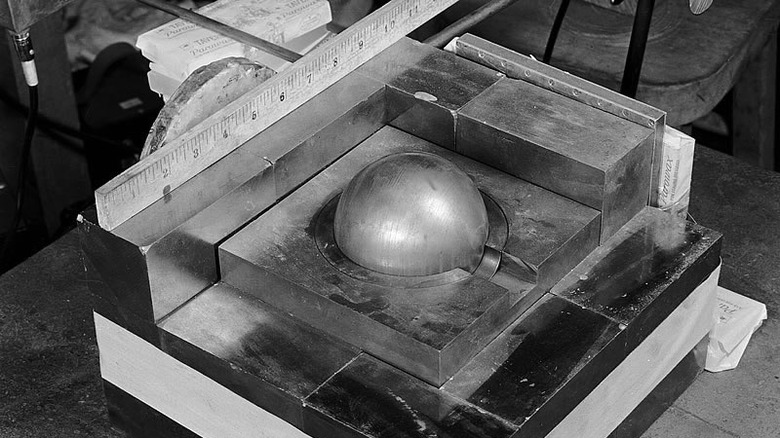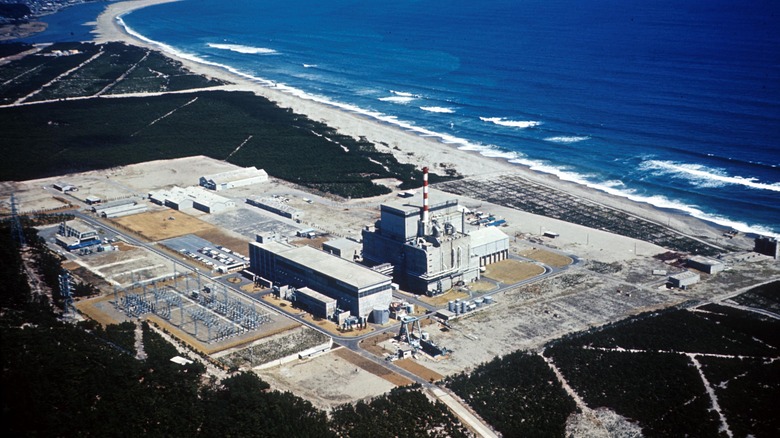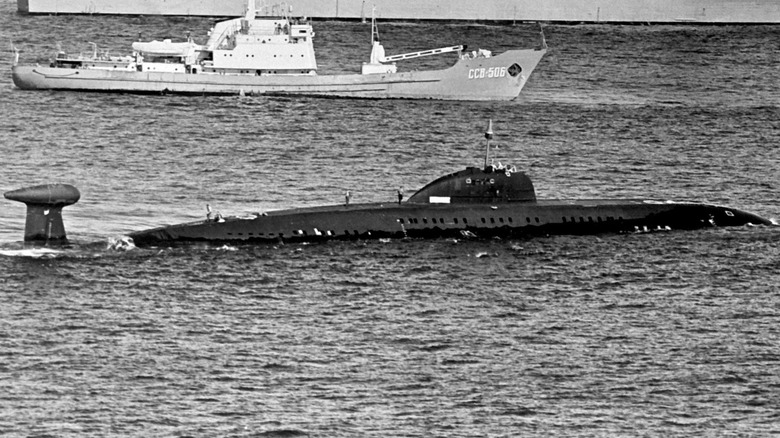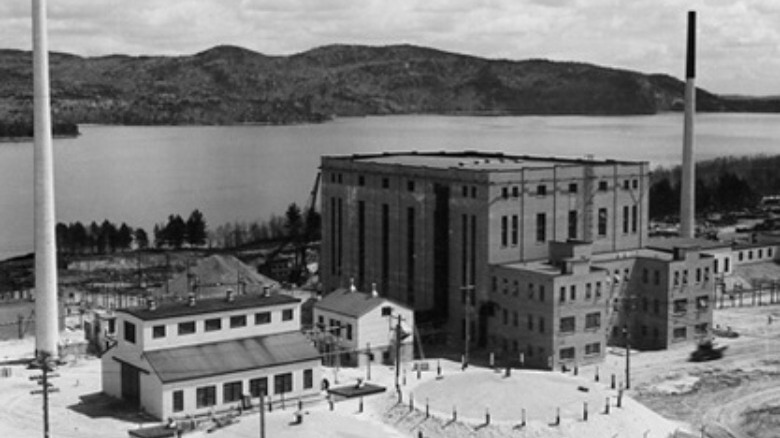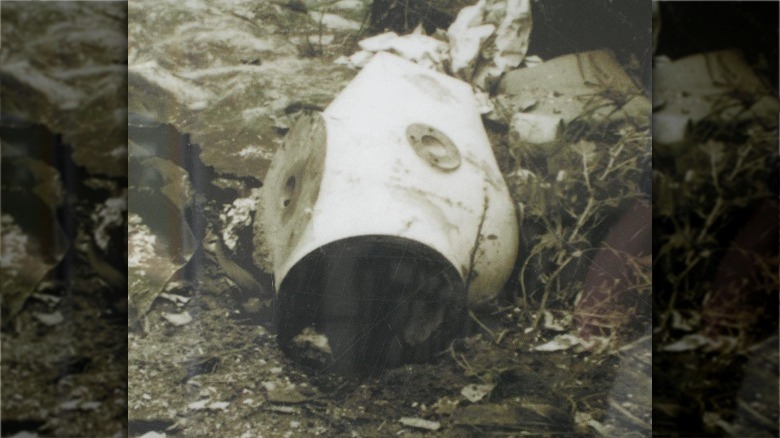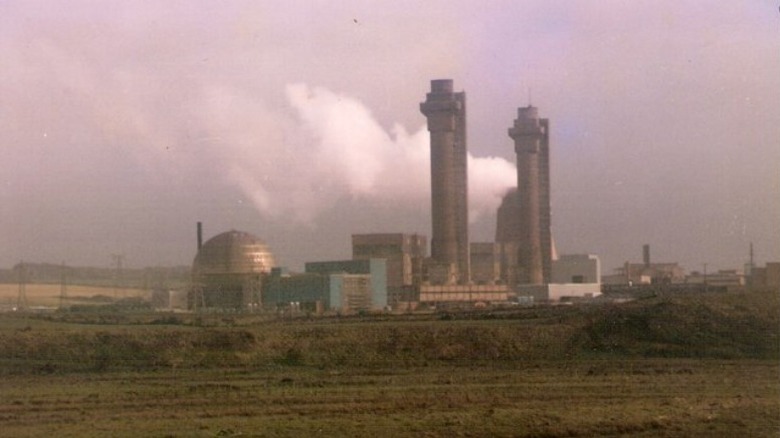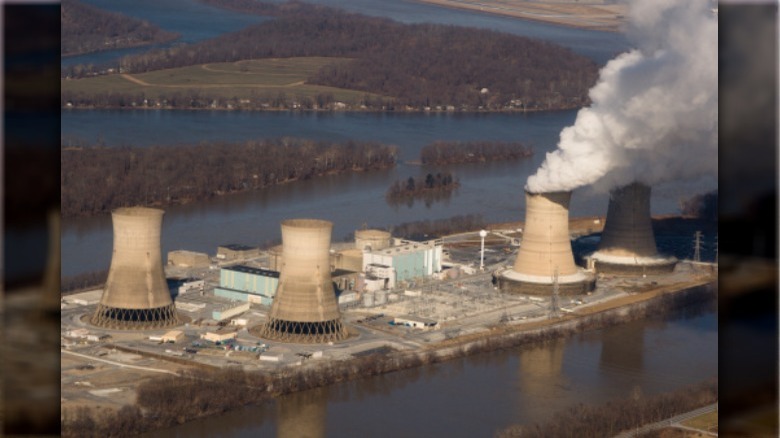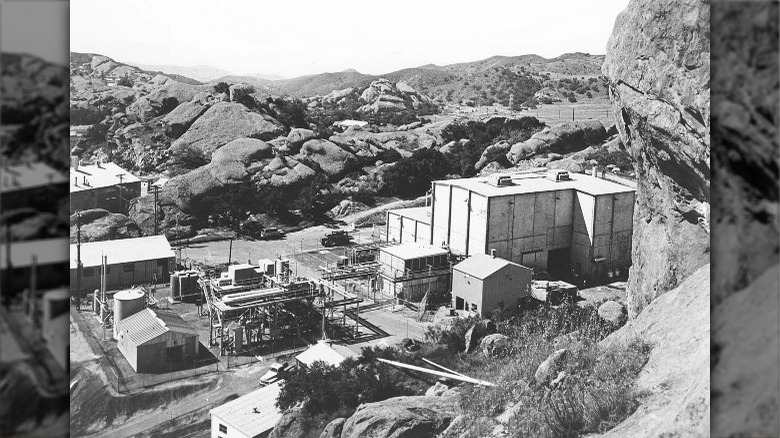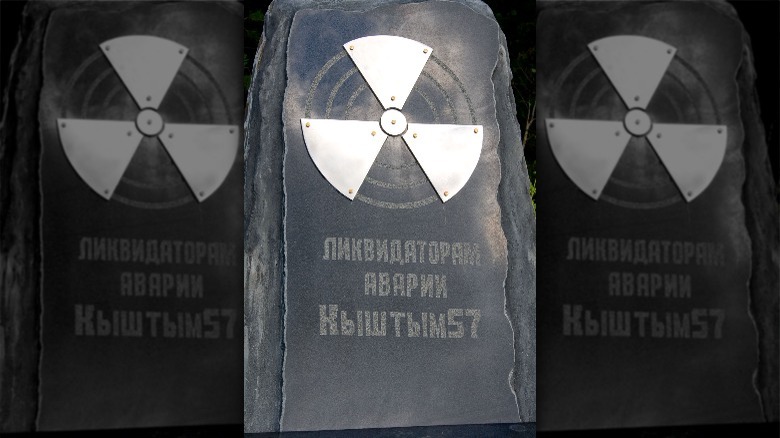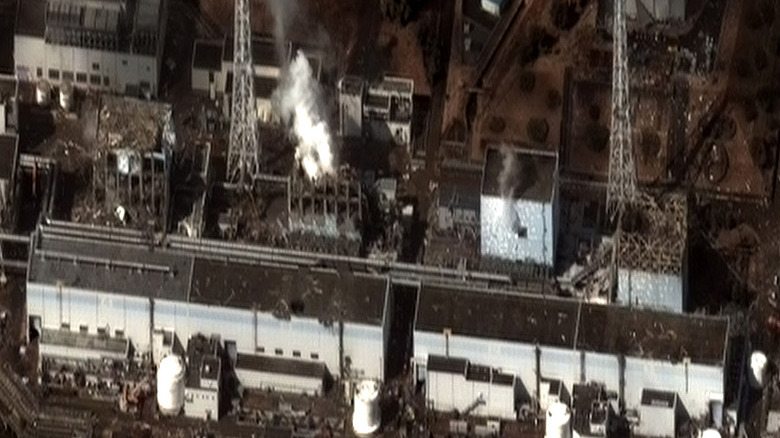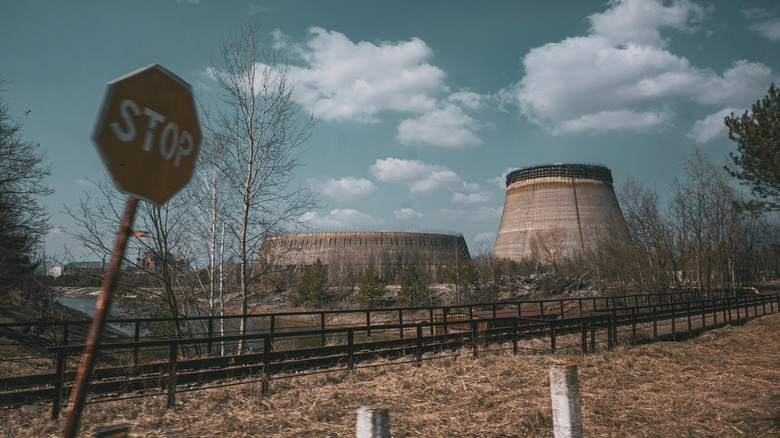The Worst Nuclear Disasters Throughout History
When you hear talk of nuclear disasters – you know, the sorts of stories that often get used to warn people away from investing into nuclear energy – it's always the same ones that get mentioned. But there are more incidents involving nuclear power and radioactive sources than the forever-infamous explosion at Chernobyl, for example.
It's not like every single brush with nuclear power leads to something being blown sky high, though. On the contrary, these sorts of incidents vary in terms of intensity and exposure. Sometimes there's a meltdown that releases tons of radioactive material into the surrounding atmosphere, or it's a case of a small nuclear power source finding its way into a public space. Sometimes there are thousands affected, or in other cases, governments worked quickly to inform the public and keep the people safe. These sorts of variations are accounted for by something called the International Nuclear Event Scale (or INES, for short). Reuters explains that on a scale ranging from one to seven, very few rank above a three, with many technically falling below the scale entirely.
That said, though, there are a number of events throughout history that have earned those higher rankings, oftentimes spewing huge levels of radiation into the atmosphere and frequently putting both workers and civilians at risk. These are some of the worst nuclear disasters that the world has ever seen.
The demon core accidents
Two of the earliest nuclear accidents both occurred at the Los Alamos National Laboratory, involved the same nuclear core, and happened within a year of each other. Strange, right? And while the two incidents are, individually, not as severe as later ones, their similarities to each other are worth mentioning.
And that's where the infamously named demon core comes into the story. Per IFLScience, after the war, the 14-pound plutonium core was repurposed for research into criticality (literally pushing the core up to the point where it would release deadly radiation). And if that sounds unsafe, then you'd be right. On August 21, 1945, Harry Daghlian went into the lab with only a security guard and surrounded the core with tungsten bricks, reflecting neutrons back toward it (via Science Alert). In the process, one of the bricks slipped and fell onto the core, which suddenly expelled heat and bright blue light – the release of huge amounts of radiation. Then, less than a year later on May 21, 1946, Louis Slotin performed a similar experiment, but rather than tungsten bricks, he used beryllium spheres. Balanced with a screwdriver. Perhaps unsurprisingly, the screwdriver slipped, completely encasing the core, and Slotin was exposed to that same blue light and heat.
Both Daghlian and Slotin died within a few weeks, but it was far from an easy death; one of the most famous images surrounding the incident is Daghlian's palm, flesh exposed after the skin peeled off in chunks.
Tokaimura
Prior to 2011, Japan's worst nuclear incident took place on September 20, 1999, at a small facility in Tokaimura that specialized in preparing nuclear fuels for larger facilities. Per The World Nuclear Organization, on that day, workers were preparing an enriched uranium mixture, but all was not well. Not only were the workers untrained for working with these types of materials, but they were also utilizing a process that had never been officially approved. They manually mixed the materials in a round, stainless steel bucket rather than a dissolution tank; in short, the lack of control offered by those factors, as well as the fact that this was all a wet process, led to tragedy. IFLScience reports that the high volume of uranium caused the mixture to hit criticality – it flashed blue as the uncontrolled nuclear reaction took over, and the three workers were knocked unconscious.
The mixture remained in that state for 20 hours, releasing radiation all the while, and the three workers were eventually found and hauled off to a hospital. All three had been dosed with high levels of radiation, but only two received doses that proved to be fatal. Extensive hospital procedures kept them alive for 83 and 211 days, respectively, but they both died of multiple organ failure after surviving a truly terrifying list of medical conditions. Just over 100 hundred others were also subject to some level of radiation, but the safety features of the facility itself fortunately kept everyone else out of danger.
Chazhma Bay, Vladivostok
Not all nuclear disasters happen in huge facilities. Not all of them even happen on land. On August 10, 1985, a Soviet nuclear submarine was docked at Chazhma Bay for routine refueling and repairs. But when repair crews lifted the lid of the reactor they also forgot to secure the control rods (via The Washington Post). Having unsecured components for a nuclear reactor sure doesn't seem like a good situation, so when a wave rocked the submarine, the control rods were lifted out of the reactor entirely. And then the reactor exploded. Ten were killed, and hundreds were exposed to radiation.
Then things started to get sketchy. The Soviet government managed to cover up the incident for years (Western outlets didn't get word of anything until the 1990s), claiming that this was a thermal explosion, not a nuclear one. And then came the cleanup. While the Soviet government did act quickly over the next two weeks, walls of nearby buildings were merely dumped in the nearby foliage, and radioactive water was unceremoniously poured into the gulf. Actively radioactive materials (like the damaged cores) were buried in the ground. What's more, The Washington Post reports that workers weren't told to wear protective gear of any kind and were generally unable to keep themselves safe, despite official claims to the contrary.
So maybe it's no surprise that a decade after the accident, the bottom of the bay was hundreds of times more radioactive than normal, and surrounding lands also showed significant levels of radiation.
Chalk River
It only makes sense that the event largely considered the world's first serious nuclear accident should make it onto this list. An article published in Quebec Science (via The Walrus) explains that the Chalk River facility, situated just north of Ottawa, was state of the art for its time, making it the prime place for nuclear experiments once it opened in 1947.
But that doesn't account for operational error. On December 12, 1952, an experiment was slated that required reduced cooling, considered safe due to a lower power input. Through a series of mistakes and miscommunications, many of the control rods were lifted out of the reactor; the combination of that with the decreased cooling meant that heat and power in the reactor kept rising. The uranium rods began to melt, and the water surrounding it began to leak into the basement after hydrogen gas caused an explosion. Leaving millions of liters of radioactive water just sitting in the facility, spreading radiation through both it and the air.
The cleanup was nightmarish, to put it lightly. CBC reports that the extreme levels of radioactivity made it impossible for workers to be inside the facility for more than 90 seconds – enough time to, say, unscrew a single bolt before being lifted back to safety. And that still had consequences. Future president Jimmy Carter was brought in to help, and his urine was reportedly radioactive for weeks. Other reports point to increased cancer rates among workers on the site, though conclusive studies were never carried out.
Goiania Incident
Not all nuclear disasters involve huge facilities and core meltdowns or explosions, and the Goiania Incident in Brazil is just one example of the contrary. Per Britannica, it took place through September 1987 and was started when a private radiotherapy clinic moved locations a couple of years prior (via IOP). The problem arose when they didn't do the best job of clearing out their equipment; a component that used cesium-137 was left behind (or stolen, depending on the account). Either way, a couple of scavengers got their hands on the radioactive parts, assuming that they make a decent profit. Ultimately, they sold it to the owner of a junkyard, who later reported that the odd metal glowed.
That really should've been a sign to stay back, but instead, the cesium component became something of a tourist attraction, with locals flocking to the junkyard just to get a look. People even took bits of the luminescent metal home with them, only for them to become deadly souvenirs.
A 6-year-old girl played with the pieces while she ate a meal and died a month later, buried in a lead coffin to protect others. Other townsfolk complained of odd medical conditions within the week. The two men who first found the source both survived, albeit with radiation burns and an amputated limb. Almost 250 were affected and four were dead by the time all was said and done. Medical authorities were alerted and led a massive cleanup effort, while the aforementioned clinic was investigated for criminal negligence.
Windscale fire
If you were to start looking for the worst nuclear accident in the history of the United Kingdom, then Britannica would direct you to the Windscale fire, which took place on October 8, 1957. As is often the case, the direct culprit was heat, but unlike in other situations, this didn't start with excess heat to the nuclear core. Instead, the graphite control blocks were to blame; routine heating quickly became less than routine, and that excess heat affected the uranium cartridges of the reactor. Those cartridges broke and the entire thing was set aflame, melting fuel into the reactor and releasing radiation. An article for the International Atomic Energy Agency adds that the flames spread across huge areas of the facility over the next couple of days, releasing even more radioactive material.
The flames were quelled by October 11, but there was also the question of public safety, especially given that shifting winds had carried radiation in all directions, even into mainland Europe. While British officials did underplay the seriousness of the situation, they also surveyed radiation levels in common foodstuffs, eventually prohibiting the distribution of certain foods to the public (particularly milk) when those levels began to rise to concerning levels.
The amount of detected radiation fell back to acceptable levels within the next couple of months, and later analysis of the effects seemed to show that this milk prohibition had done its job effectively.
Three Mile Island
Widely known as the worst nuclear disaster in American history (and quoted as such by History), the accident at Three Mile Island had rather inauspicious beginnings. Early in the morning on March 28, 1979, the facility's new reactor experienced a malfunction having to do with its cooling units. Per The World Nuclear Association, the unit began to heat up, causing an automatic emergency shutdown, but in the process, a valve failed to close entirely. The core continued to lose coolant, and the temperatures continued to rise.
Unfortunately, operators didn't know exactly what to do, and they also didn't have all the information, due to technical limitations in the facility. Once they realized something was still wrong, their attempts to de-escalate the situation did the exact opposite, and even once the situation was under control, the damage had already been done. The core had partially melted, exposing workers to dangerous levels of radiation, and a bubble of hydrogen gas had formed, which some officials feared might explode.
The bubble was vented off safely (in reality, there was little chance of explosion), and in the end, there was fairly little exposure to radioactive materials outside of the facility. But that didn't stop the public from panicking. Rumors spread by the media and politicians led to widespread fear, and thousands of people fled from their homes in the days following the accident. That fear remained until President Jimmy Carter arrived on the scene to help assess the situation, finally giving locals back their peace of mind.
Santa Susana Field Lab
If there had been a nuclear accident in the middle of Los Angeles, you would've heard of it, right? It's LA – how could the public at large not know about something like that? Well, not only is that situation possible, but it actually happened at the Santa Susana Field Lab on July 13, 1959.
From the start, the lab was pretty sketchy. Per NBC, it was constructed with the explicit purpose of conducting secret research; initially, that was rocket engines, but eventually, that included nuclear reactors. What's more, the facility was testing something new: the Sodium Reactor Experiment, which cooled reactor cores using sodium. Lower pressure, but more dangerous, as sodium is violently reactive with both air and water (via Pacific Standard). And that increased danger led to a pretty bad situation; according to VC Star, steel tubes began to melt into the uranium core – a partial nuclear meltdown.
But the real problem came after. Reports to the public claimed that no nuclear radiation had leaked, but in reality, the core was turned on and off over the next couple of weeks, venting radioactive gasses all over the surrounding area. Two fuel rods broke off during the cleanup and fell into the core, causing further panic among the workers (who were given protective equipment that would now be considered subpar) and pumping even more radioactive material into the air. Estimates say that the incident released 15 to 260 times more radiation than Three Mile Island, yet it was kept under wraps for decades.
Kyshtym
From the start, the secret Soviet nuclear facility known as "Mayak" in the Kyshtym industrial complex was operating without much regard for safety. Per Environment and Society, the facility was already dumping nuclear waste into rivers and sending thousands to hospitals throughout the 1940s. But on September 29, 1957, things changed. One of the containers holding nuclear waste hadn't been properly maintained, allowing the decaying radioactive waste to continually heat up (via Britannica). And, well, heat and nuclear waste don't exactly play nicely together. A huge explosion shook the facility, blowing off the concrete lid and launching radioactive cesium-137 and strontium-90 into the air. Then, the wind blew the nuclear isotopes toward populated areas.
The government was slow to react, but civilians were suddenly told to kill their animals and evacuate their villages. No explanation was ever given to those affected, but it was clear enough to them what happened as those suffering from radiation sickness flooded into hospitals. And that was about all that the Soviet government did, choosing to keep the incident under wraps (they continued to deny its existence until 1989).
Even stranger, though? Reports of the accident cropped up in Western news reports almost immediately, but no American officials gave any answers. An emigrant from the Soviet Union, Zhores A. Medvedev, raised awareness about the accident in 1976, and eventually, the CIA corroborated his story. It turned out they had learned the details back in 1960 but refused to release information, fearing it would lead to doubts about the American nuclear program.
Fukushima Daiichi
While a number of the incidents on this list are pretty notorious historical events, it's pretty likely that there's one nuclear disaster that you're particularly aware of: the 2011 Fukushima Daiichi accident. It made major headlines that are hard to forget, but here are a few more of the details of just what happened.
A magnitude-9.0 earthquake hit Japan on March 11, 2011, dealing massive damage to the country; that said, The World Nuclear Association explains that the earthquake itself didn't actually damage the reactors at Fukushima Daiichi. The real issue came from the resulting tsunami. While eight of the 11 nuclear units were successfully shut down, the facility housing three of them was flooded. The water disabled most of the generators, meaning that the units couldn't be cooled. Per Britannica, the heat melted some of the fuel rods, exposing the nuclear cores. Building pressure also led to a number of explosions at the facility, leading to the release of huge amounts of radioactive material, which was detected in the surrounding water and food.
Tens of thousands of people were evacuated from their homes in the following days, and even those outside of the official evacuation area were ready to leave, should the situation get any worse. Fortunately, no deaths were reported, but the accident is still considered one of the two most serious in history, solely due to the amount of radioactive material released.
Chernobyl
When it comes to nuclear disasters, there's typically one name in particular that comes to anyone's mind: Chernobyl. And, well, that's for a pretty good reason. After all, the explosion at the Soviet (now Ukrainian) power plant is largely considered the worst nuclear disaster in history.
According to National Geographic, in 1977, the Soviet Union was investing hard in nuclear power, so they installed four new nuclear reactors at the power plant just northwest of the city of Chernobyl. For almost a decade, the power plant was in operation and managed to avoid major incidents, but on April 25, 1986, some workers at the plant decided to do a bit of unofficial science. While running maintenance on one of the reactors, they violated major safety regulations and, per Britannica, shut down regulatory and safety systems and even removed the control rods. Shortly after 1 a.m. on the 26th, a chain reaction of explosions shook the facility; between the explosions themselves and the loss of physical containment structures, the nuclear core spread radiation to the surrounding area.
The Soviet Union tried to keep the tragedy quiet, but within just a couple days, countries as far as Sweden were able to detect increased radiation in the air (eventually, the radiation would reach as far west as France). With the explosion releasing nearly 60 metric tons of radioactive material, the Chernobyl Exclusion Zone was established, but the casualty count was still high. It's estimated that 28 people died in the immediate aftermath, and thousands developed cancers due to radiation exposure.
